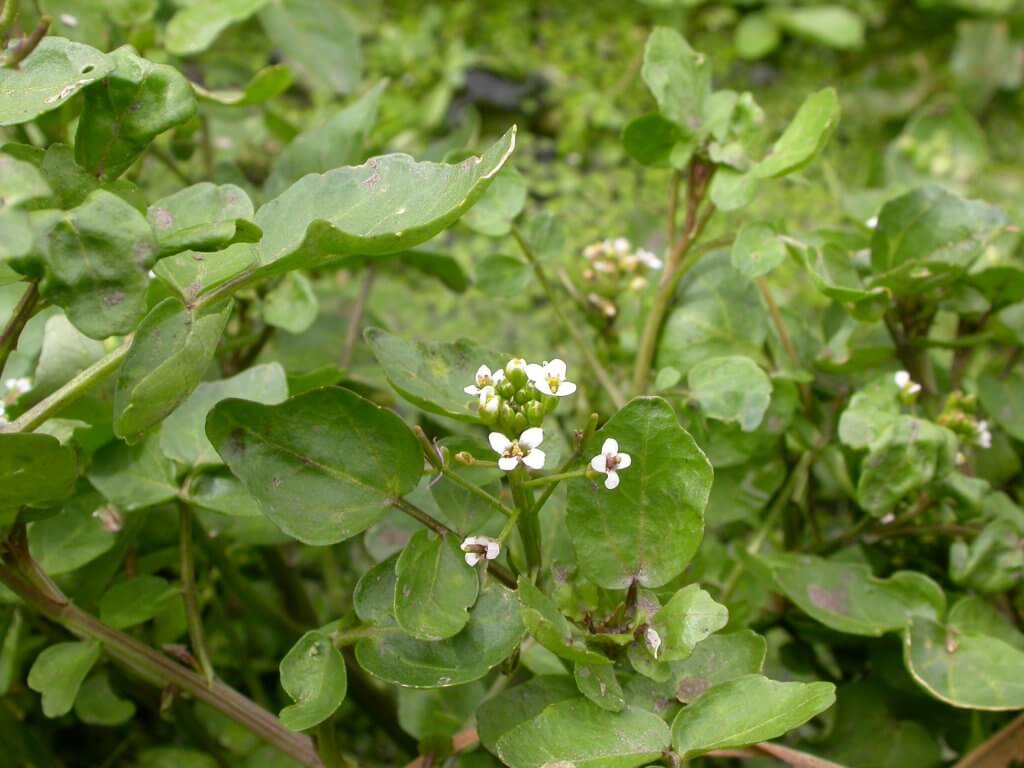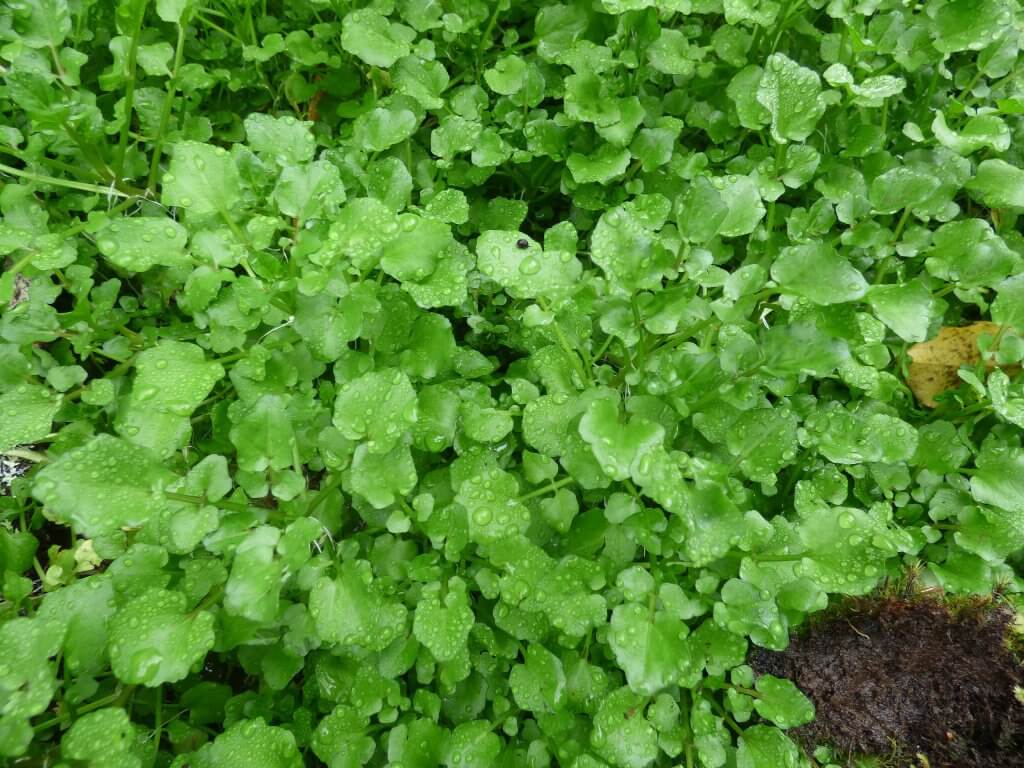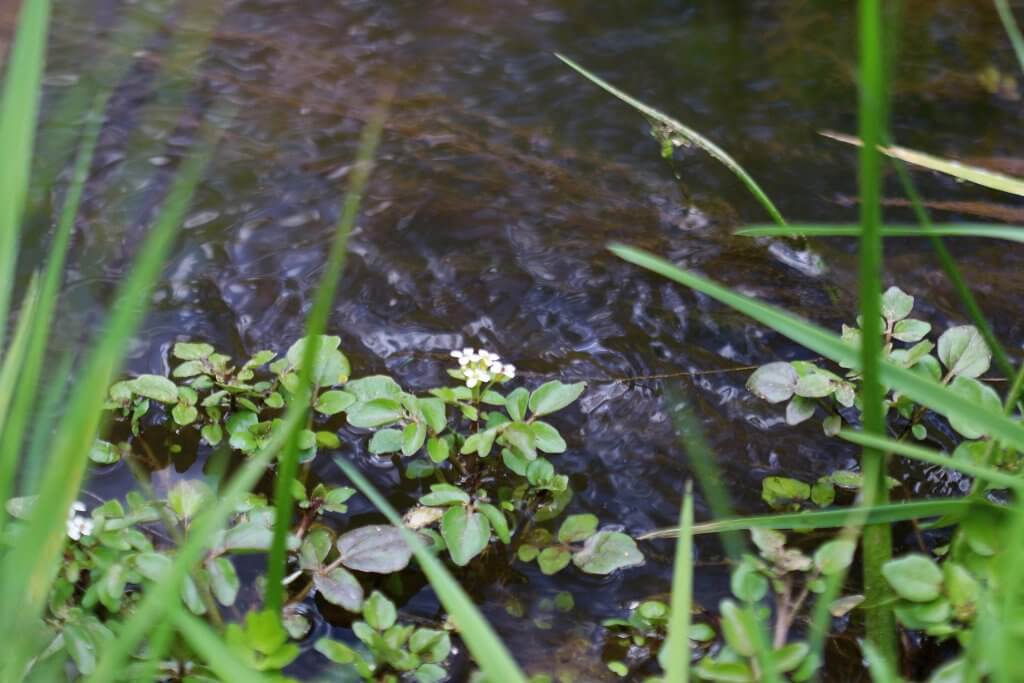Watercress (Nasturtium officinale), is a peppery flavored, perennial member of the mustard family, Brassicaceae. A leafy plant that favors very moist, and essentially aquatic conditions, it grows wild upon the surface of rivers, lakes and streams.

Once native to Europe and temperate Asia, it is now largely widespread throughout the world, grown as a crop which will often escape into the wild. Once established, plants will often cluster together forming dense carpets of leaves which sit at the surface of the water. When mature, the trailing stems can reach lengths of up to 100cm.
The leaves are oval shaped and sit opposite each other along narrow stems, terminating in one larger leaf. It flowers through late spring and summer, with clusters of loosely arranged, small white flowers.
Edible parts and other uses
The young leaves and stems have a light and peppered flavor, similar to winter cress. This makes them perfect for salads and sandwiches. They also work well as a cooked leafy green too, from soups to a stir fry, the succulent leaves work well in a huge array of dishes.
Watercress has an extremely extensive history as a food source and a herbal remedy. It is even believed to be one of the oldest leafy greens ever harvested and eaten. From inflammations to treating coughs, colds, scurvy and bruising, watercress was taken internally and even applied to the skin to soothe and heal. The Romans even believed that watercress could prevent balding.

Farmed watercress is usually grown within contained and monitored fields fed with fresh spring water. This removes the worry of contamination from pollutants or parasites that could be present in rivers or streams.
After commercial watercress farming began and scientific studies emerged, many people steered away from consuming wild watercress, as it was believed to be unsafe. As a wild edible whose safety depends so heavily on the quality of the water, it can be a little off-putting to some foragers.
If you are harvesting watercress from the site of a fresh spring, in free flowing water there is the possibility of eating it raw (still with some thorough washing). However any uncertainty means you should only consume wild watercress when cooked through (thorough cooking eliminates bacteria and parasites). And, you should never harvest it from areas downstream of human or livestock activity.
Cautions
Watercress can occasionally be confused with nasturtiums due to their naming, however both plants are edible.
Studies have confirmed that watercress growing in conditions close to cows and sheeps (essentially areas with high amounts of manure) can harbour some parasitic organisms. The main culprit is the liver fluke, which can cause diseases in humans as well as livestock.
Watercress can also contain compounds that can alter the effectiveness of some drugs. They specifically have an inhibiting affect if you are taking drugs to control muscle spasms and pain.
Foraging
Make sure to forage watercress in locations away from farms. The best place to forage would be in clear running water, far upstream of any human/livestock activity. A spring is the best place to look for wild watercress if you plan on eating it raw in salads. After flowering the leaves can become bitter, so harvesting is best within winter and early spring.

Did you know…
The popular and commonly called nasturtium annual bedding plants hold the same common name as the genus of watercress Nasturtium. These flowering plants actually belong to the Tropaeolum genus. Although very different in appearance, they are also edible. The only similarities that caused this dual naming are because nasturtiums produce a peppery tasting oil very similar to watercress.
Conclusion
Highly nutritious, with considerable levels of vitamins A, C and K and a number of minerals, watercress is a great edible to add into your recipes. Do not let the cautions put you off too much, with considered foraging, watercress is safe and rewarding. Any doubts, and cooking through the watercress will remove any risks if present.
—————Written by Hannah Sweet
Hannah is a freelance writer and graphic designer from the UK. With a penchant for travelling, photography and all things botanical, she enjoys writing about a wealth of topics and issues, from conservation and slow living, to design and travel. Learn more about her writing and design services at www.sweetmeanders.co
Many of our readers find that subscribing to Eat The Planet is the best way to make sure they don't miss any of our valuable information about wild edibles.
See our privacy policy for more information about ads on this site






